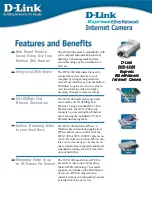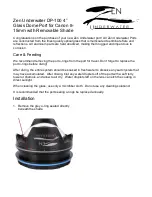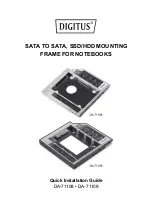
MOUNTING AND ATTACHING FLASHES
Depending on which strobe system you are using, you can mount the necessary shoes or brackets or Base Ball onto the threaded holes on the top of
the hand grips. Use of the Aquatica TLC Strobe Arm System is recommended.
There are also three 1/4”-20 threaded holes on the bottom of the housing that can be used for various mounting applications. For example, A mounting
tray can be fitted on the bottom of the housing. A 1/4”-20 threaded hole on top of the rear half of the housing will accept an Aquatica bracket or Base Ball
that can hold a small dive light or a strobe arm.
FOR WIRED CONNECTORS
Internal switch board circuit:
Your Aquatica D300s Digital housing is supplied with either one or two Nikonos type
connectors which are in turn connected to a switch board circuit that will allow you to choose
between full manual exposure or iTTL (an external converter or single housed flash is required). Optional Ikelite bulkheads connectors
are also available.
When preparing the sync cord be sure to lubricate the O-ring on the sync cord’s connector with a light coat of Aquatica
O-ring lubricant, Also advisable is to put a light coat of O-ring lubricant on the threads of this connector.
Your Nikon Digital camera design does not allow two flashes to be electrically connected directly to the camera, whether in a housing
or on dry land, this is due to the wireless approach used by them for triggering the additional flashes, when two flashes or strobes are
connected directly to the camera, iTTL will stop to function and a camera freeze is likely to happen.
On your housing you will find one or two bulkhead connectors, the main connector is wired through a switch board that will allow you to
take full advantage of iTTL exposure, the secondary (if installed) connector is always in full manual configuration and cannot be used
for iTTL operation. By default you housing is delivered with the switch board set to full manual, if the iTTL exposure is desired then it
can be made in either of two methods:
1) By using a single flash from Nikon or other brand (that is iTTL compatible with your camera) in a underwater housing connected
with a TTL cord to the main connector of your Aquatica housing.
2) By using an external iTTL converter connected to the main connector of your Aquatica housing, one or two underwater strobes with
TTL cords which are then connected to this converter, (check strobe and converter manufacturer for compatibility).
Set up instruction for iTTL operation:
Using the tip of a pen push the switches 1, 2 & 3 to the ON (up) position, this will activate the
connections on your main bulkhead connector allowing TTL communication between the camera and the housed flash or iTTL converter.
Set up instruction for manual operation:
All switches must be in the OFF (lower) position, in this case all iTTL connection are disabled
and only the ground and sync are left active, this will allow two under water strobes or housed flashes to be connected directly via the
main and secondary bulkhead.
FOR OPTICAL CONNECTORS
The housing with optical connectors are supplied with adapter for typical straight cord used by
INON and various strobe manufacturers and angled Sea & Sea type cords, select the desired
connection and install on the optical port base, tighten the set screw into place with the supplied
hexagonal wrench.
In order to to use Opticall triggering, the built-in flash of the camera need to be in the up posi-
tion, this can be done at time of installation or later by using the knob (key # 7) and rotating it to
release it to the up position. Select the proper sync mode (rear, slow, etc.).
Note:
it is advisable to turn the camera and external strobe off when travelling to your dive site
in order to avoid useless drain of the camera and strobes the batteries. Field testing as shown
that mixing brand of strobes give unreliable result and should be avoided.
Remember not to install the hot shoe if shooting optically triggered strobes (HYB version) as this hot shoe disengages the internal
built-in flash of the camera and prevent this later from triggering. Always do a few test exposures once you finished setting up the
strobes
page 9
Sea & Sea Type angle
INON Type Straight cord


































